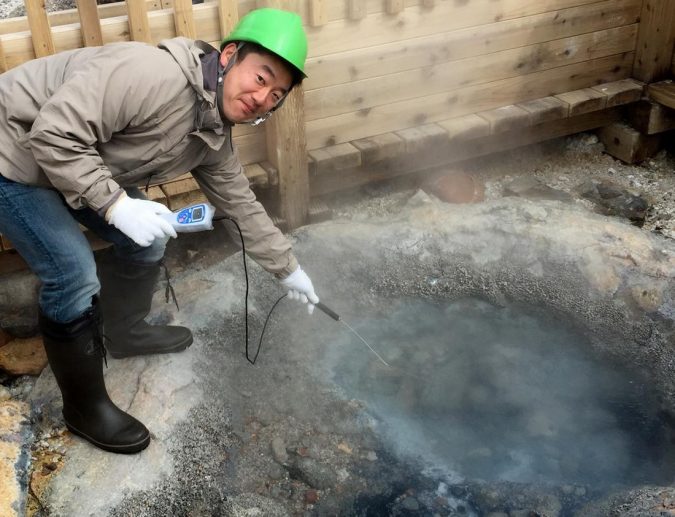|
Getting your Trinity Audio player ready...
|
Tomohiro Mochizuki tracks down viruses inside single-cell organisms thriving in boiling hot springs. His fieldwork is conducted in relatively extreme environments and, despite the significance of his investigations, he doesn’t need many fancy gadgets back at his lab at Japan’s Earth-Life Science Institute (ELSI). ARN asked Mochizuki about his virus-hunting exploits and what they involve. Via Researchsea.

Q: The COVID-19 pandemic has made people more aware of viruses and how they function. But you study viruses that most people won’t have heard of.
A: Viruses are everywhere on our planet and are found in every known cellular organism, from simple organisms like archaea and bacteria, to the more complex organisms known as eukaryotes, which include plants and animals. I work on viruses that infect hyperthermophilic archaea: nucleus-free, single-cell organisms that thrive in environments hotter than 80°C.
Q: What’s so special about archaeal viruses?
A: Archaea, especially those that thrive in high temperatures, are thought to have played a key role in the early evolution of life. Many scientists believe our last universal common ancestor (LUCA) was a thermophilic organism that may have been very similar to today’s hyperthermophilic archaea. By learning about viruses in present-day hyperthermophilic archaea, we hope to get a grasp on the kind of viruses that existed billions of years ago. My long-term goal is to unravel the LUCA-era virosphere.
Q: You’ve discovered several viruses. What can you tell us about them?
A: I have discovered nearly half of all the known 24 viral families that infect archaea. Among the ones I found, the most significant, evolutionarily speaking, is Spiraviridae virus ACV (Aeropyrum coilshaped virus). This was the first singlestranded DNA (ssDNA) virus found in hyperthermophilic archaea. All archaeal viruses found up until that point had double-stranded DNA (dsDNA) genomes, which were thought to be more stable physico-chemically.
Finding a hyperthermophilic archaeal ssDNA virus suggests RNA viruses might exist in elevated temperature conditions, although this has not yet been proven. The textbook theory is that life started in a hot thermal environment with RNAgenomed cells, even though RNA is known to be extremely sensitive to heat. Finding a thermophilic RNA virus in the modern biosphere could help fill a missing gap.
Q: What are you working on now?
A: One of my most recent findings is starting to look quite interesting. We found a new virus whose ancestral lineage seem to be quite ancient.
Q: What kind of equipment do you need during your fieldwork and what does your lab at ELSI look like?
A: Researchers who do field work in hot springs to study thermophiles have different approaches. Rather than spending a long time at a single source site, I try to collect hot water samples from as many sources as possible, from locations mainly in Japan but also in France, Italy and the US. On-site, I’ll measure temperature, acidity, salinity, and collect several hundred millilitres of water, often in several different tubes. So things are not too complicated.
Over the years, I have equipped my lab at ELSI with high-temperature incubators and gassing systems for preparing anaerobic cultures. I do not use too many fancy, cutting-edge analytical machines. But there are two things I cannot survive without: an ultracentrifuge to separate viral particles and an electron microscope to observe them. We have an ultracentrifuge at ELSI and share an electron microscope with the Tokyo Institute of Technology.
ELSI is a multidisciplinary institute. Our bio unit includes four researchers supported by the World Premier International Research Center Initiative (WPI) and about 15 students, postdocs and technicians. Our lab space is also shared with researchers in other fields, such as chemists and geochemists. We have around 60 users annually, including temporary visitors.
Q: What are the various managerial roles you play to keep your research work going?
A: Our lab is shared between many people of different nationalities, research specialties and backgrounds. It is the most highly populated unit at ELSI. This means we have the largest budget, and I am in charge of handling this. Together with my colleagues, we try to maintain a healthy working environment, including ensuring lab safety.
Q: What do young researchers need to learn in order to run their own research labs?
A: It’s a tough question, especially since I am still learning myself. I’d say it’s most important to have a flexible mindset and to consider what would bring the most happiness to the most people you work with.
Q: What do you find rewarding about your work?
A: I feel most rewarded when I get an extremely interesting lab result, like when I find a new virus, which often happens in the electron microscope room. I also really enjoy presenting to people who are not familiar with my field and seeing them get excited about the research I do.







